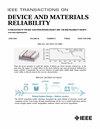Ion Radiation Effects on the Stability of Hafnium Oxide-Based Ferroelectric Thin Films: Mechanisms and Regulation
IF 2.3
3区 工程技术
Q2 ENGINEERING, ELECTRICAL & ELECTRONIC
IEEE Transactions on Device and Materials Reliability
Pub Date : 2025-03-13
DOI:10.1109/TDMR.2025.3550950
引用次数: 0
Abstract
With the advancement of information technology, ferroelectric memories have garnered significant attention due to their non-volatility, high theoretical storage density, low power consumption, and excellent radiation resistance. Hafnium oxide-based ferroelectric materials have a high dielectric constant, a relatively wide bandgap, and good compatibility with CMOS processes, making them suitable for developing the next generation of ferroelectric memories. However, the stability issues hafnium oxide-based ferroelectric thin films face during service, including the wake-up effect and poor polarization retention, hinder the commercialization process of hafnium oxide-based ferroelectric memories developed from these thin films. This paper explores the possibility of optimizing the stability issues of HfO2-based ferroelectric thin films through ion irradiation based on a phase-field model of hafnium oxide-based ferroelectric thin films. The research results show that ion irradiation can effectively weaken the wake-up effect and improve the retention of the thin films. After irradiation with H, He, Fe, and Ar ions, the increase in remanent polarization values of HfO2-based ferroelectric thin films after wake-up was significantly reduced compared to the increase observed in non-irradiated films. Among them, the thin films irradiated with Ar ions showed the smallest increase in remanent polarization after wake-up, at only 9%, while the non-irradiated films exhibited a much higher increase of 260%. Additionally, the ten-year polarization retention efficiencies of the films post-irradiation were also excellent, reaching 95.2%, 93.3%, 92.7%, and 94.5% for H, He, Fe, and Ar ions, respectively. Since Ar ions most effectively reduce the wake-up effect and enhance polarization retention, this study recommends using Ar ions to optimize the stability of hafnium oxide-based ferroelectric thin films. This study provides new insights into optimizing HfO2-based ferroelectric thin films and explores their potential applications in ferroelectric memories.离子辐射对氧化铪基铁电薄膜稳定性的影响:机理与调控
随着信息技术的进步,铁电存储器因其非易失性、高理论存储密度、低功耗和优异的耐辐射性而备受关注。氧化铪基铁电材料具有较高的介电常数、相对较宽的带隙以及与CMOS工艺的良好兼容性,适合开发下一代铁电存储器。然而,氧化铪基铁电薄膜在使用过程中面临的稳定性问题,包括唤醒效应和差的极化保留,阻碍了由这些薄膜开发的氧化铪基铁电存储器的商业化进程。本文基于氧化铪基铁电薄膜的相场模型,探讨了离子辐照优化hfo2基铁电薄膜稳定性问题的可能性。研究结果表明,离子辐照可以有效地减弱唤醒效应,提高薄膜的保留率。经H、He、Fe和Ar离子辐照后,唤醒后hfo2基铁电薄膜的剩余极化值的增加比未辐照薄膜的增加明显减少。其中,经Ar离子辐照的薄膜唤醒后的剩余极化增加幅度最小,仅为9%,而未辐照的薄膜唤醒后的剩余极化增加幅度更大,达到260%。此外,辐照后膜的十年极化保持效率也很好,H、He、Fe和Ar离子的十年极化保持效率分别达到95.2%、93.3%、92.7%和94.5%。由于Ar离子最有效地降低了唤醒效应,增强了极化保留,因此本研究建议使用Ar离子来优化氧化铪基铁电薄膜的稳定性。该研究为优化hfo2基铁电薄膜提供了新的见解,并探索了其在铁电存储器中的潜在应用。
本文章由计算机程序翻译,如有差异,请以英文原文为准。
求助全文
约1分钟内获得全文
求助全文
来源期刊

IEEE Transactions on Device and Materials Reliability
工程技术-工程:电子与电气
CiteScore
4.80
自引率
5.00%
发文量
71
审稿时长
6-12 weeks
期刊介绍:
The scope of the publication includes, but is not limited to Reliability of: Devices, Materials, Processes, Interfaces, Integrated Microsystems (including MEMS & Sensors), Transistors, Technology (CMOS, BiCMOS, etc.), Integrated Circuits (IC, SSI, MSI, LSI, ULSI, ELSI, etc.), Thin Film Transistor Applications. The measurement and understanding of the reliability of such entities at each phase, from the concept stage through research and development and into manufacturing scale-up, provides the overall database on the reliability of the devices, materials, processes, package and other necessities for the successful introduction of a product to market. This reliability database is the foundation for a quality product, which meets customer expectation. A product so developed has high reliability. High quality will be achieved because product weaknesses will have been found (root cause analysis) and designed out of the final product. This process of ever increasing reliability and quality will result in a superior product. In the end, reliability and quality are not one thing; but in a sense everything, which can be or has to be done to guarantee that the product successfully performs in the field under customer conditions. Our goal is to capture these advances. An additional objective is to focus cross fertilized communication in the state of the art of reliability of electronic materials and devices and provide fundamental understanding of basic phenomena that affect reliability. In addition, the publication is a forum for interdisciplinary studies on reliability. An overall goal is to provide leading edge/state of the art information, which is critically relevant to the creation of reliable products.
 求助内容:
求助内容: 应助结果提醒方式:
应助结果提醒方式:


